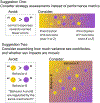Sex mechanisms as nonbinary influences on cognitive diversity
- PMID: 38643533
- PMCID: PMC11338071
- DOI: 10.1016/j.yhbeh.2024.105544
Sex mechanisms as nonbinary influences on cognitive diversity
Abstract
Essentially all neuropsychiatric diagnoses show some degree of sex and/or gender differences in their etiology, diagnosis, or prognosis. As a result, the roles of sex-related variables in behavior and cognition are of strong interest to many, with several lines of research showing effects on executive functions and value-based decision making in particular. These findings are often framed within a sex binary, with behavior of females described as less optimal than male "defaults"-- a framing that pits males and females against each other and deemphasizes the enormous overlap in fundamental neural mechanisms across sexes. Here, we propose an alternative framework in which sex-related factors encompass just one subset of many sources of valuable diversity in cognition. First, we review literature establishing multidimensional, nonbinary impacts of factors related to sex chromosomes and endocrine mechanisms on cognition, focusing on value- based decision-making tasks. Next, we present two suggestions for nonbinary interpretations and analyses of sex-related data that can be implemented by behavioral neuroscientists without devoting laboratory resources to delving into mechanisms underlying sex differences. We recommend (1) shifting interpretations of behavior away from performance metrics and towards strategy assessments to avoid the fallacy that the performance of one sex is worse than another; and (2) asking how much variance sex explains in measures and whether any differences are mosaic rather than binary, to avoid assuming that sex differences in separate measures are inextricably correlated. Nonbinary frameworks in research on cognition will allow neuroscience to represent the full spectrum of brains and behaviors.
Keywords: Decision making; Executive function; Reward; Sex differences; Strategies.
Copyright © 2024 The Authors. Published by Elsevier Inc. All rights reserved.
Figures

References
-
- Aarde SM, Genner RM, Hrncir H, Arnold AP, Jentsch JD, 2021. Sex chromosome complement affects multiple aspects of reversal-learning task performance in mice. Genes Brain Behav. 20, e12685. - PubMed
-
- Abdulai-Saiku S, Gupta S, Wang D, Moreno AJ, Huang Y, Srivastava D, Panning B, Dubal DB, 2022. The maternal X chromosome impairs cognition and accelerates brain aging through epigenetic modulation in female mice. bioRxiv. 10.1101/2022.03.09.483691. - DOI
-
- Ambrase A, Lewis CA, Barth C, Derntl B, 2021. Influence of ovarian hormones on value-based decision-making systems: contribution to sexual dimorphisms in mental disorders. Front. Neuroendocrinol 60, 100873. - PubMed
Publication types
MeSH terms
Grants and funding
LinkOut - more resources
Full Text Sources
Research Materials

